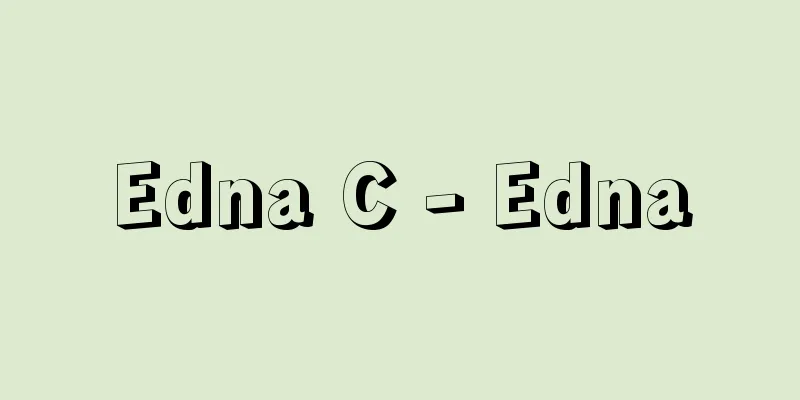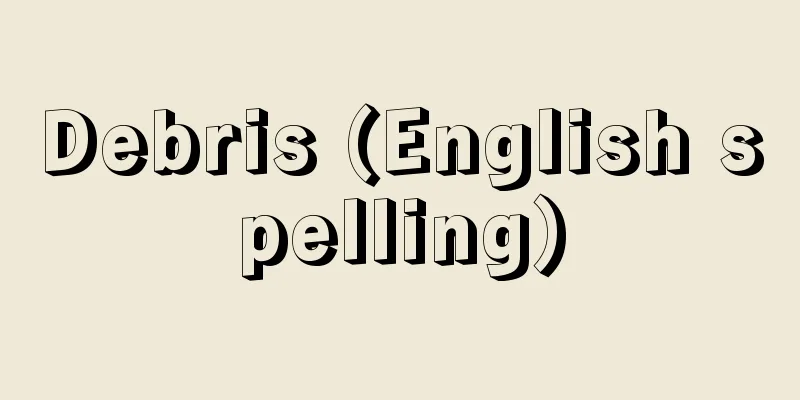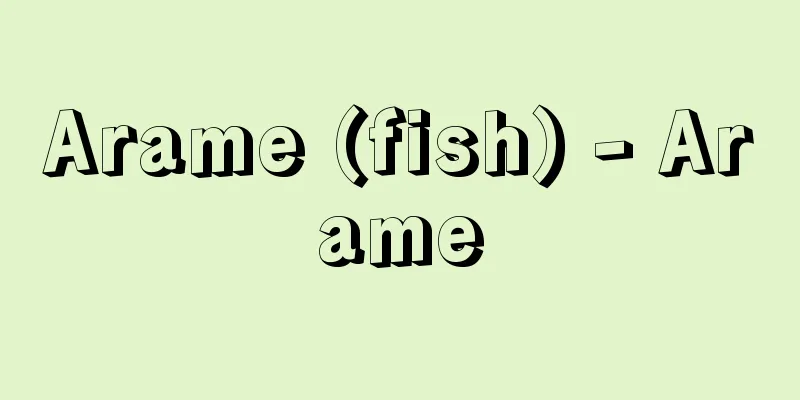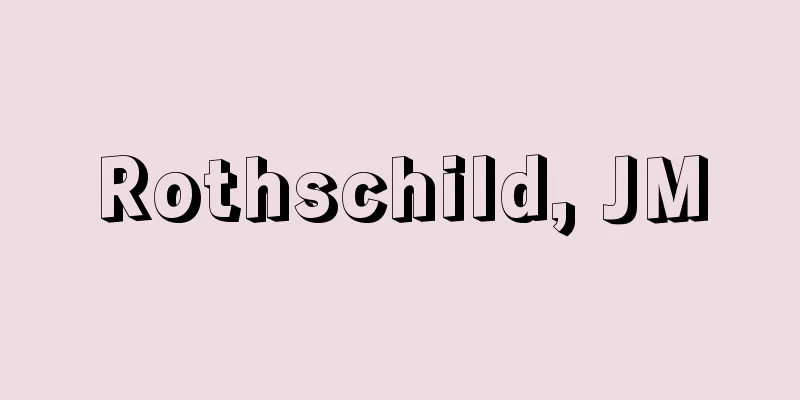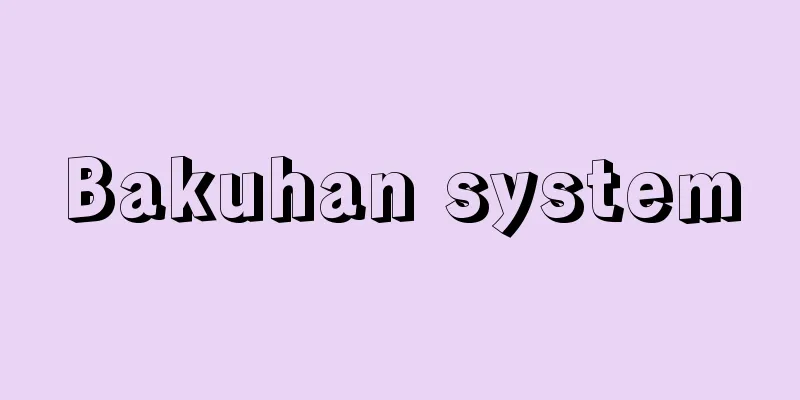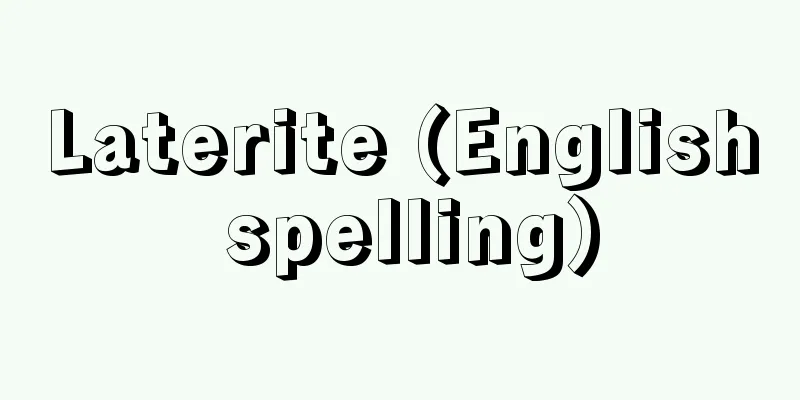Czech Republic (English spelling)

|
A republic located in central Europe. It is a landlocked country surrounded by Germany to the west, Poland to the northeast, Slovakia to the southeast, and Austria to the south. Its official name is the Czech Republic. In English, it is Czech Republic. It is made up of Bohemia and Moravia (including parts of Silesia). Although the Japanese word "Czech" refers to the whole country, the Czech word "Čechy" generally refers to Bohemia, and there is no established name in Czech that refers to the whole territory. To refer to the whole country, the official name or historical expression "České země", which means "Czech territories", is used. Czech Republic and neighboring Slovakia formed a federal state, Czechoslovakia, but in 1992, the leaders of the Czech Republic and Slovakia decided to dissolve the Czechoslovak federation and each country to become an independent country, and the Czech Republic was established in 1993. The country has an area of 78,867 square kilometers and a population of 10,287,000 (estimated as of 2006). The capital is Prague. For information on the country's natural features and history, see the Czechoslovakia entry. [Taizo Nakamura and Mizuho Nakata] GeographyThe Czech Republic is blessed with mineral resources, and mining and manufacturing developed early on, making it an industrially developed region even during the Czechoslovak era. Agriculture has also developed around sugar beets, beer barley, hops, fruit trees, vegetable cultivation, dairy farming, and pig farming. In the Bohemian region, the plains along the Labe River east of Prague are blessed with fertile black and brown soils, and are known as the "golden zone" for growing wheat and sugar beets. Bohemia's industries are distinctive in each region. The Sudety foothills are home to thriving textile and glass product manufacturing industries. In the Krušine Hory mountains, chemical and heavy machinery industries have developed using imported raw materials and local lignite as an energy source. Heavy machinery industries have also developed in Plzen (Pilsen), famous for beer production in the southwest, while machinery, ferrous metallurgy, chemical and consumer goods manufacturing industries have developed in Prague. Moravia is home to the Ostrava-Karbina coalfield in the north, and its main industries are steel, chemicals, and machinery (mining equipment, heavy trucks). Leather and furniture industries are also developing. Brno, the center of Moravia, is home to heavy machinery such as turbines, as well as precision machinery industries such as watches and ball bearings. Another major industry in Moravia is the food industry, which uses agricultural products (wheat, beer barley, corn, sugar beets, grapes) developed in central and southern Moravia as raw materials. Tourism has grown rapidly since the Velvet Revolution of 1989 (a bloodless transition from communism). Fortunately, the country was largely spared from the ravages of World War II, and many historical buildings from various eras have been preserved throughout the country, making them a valuable tourist resource. Many foreign tourists are welcomed to the capital Prague, as well as to the hot spring resorts of Western Bohemia, the historic centre of Cesky Krumlov and Telč, both registered as UNESCO World Heritage sites, the pilgrimage church of St. John of Nepomuk in Zelená Hora, the historic city of Kutná Hora with the Church of St. Barbara and the Cathedral of Our Lady of Sedlec, Litomyšl Castle, and Brno in Moravia, with the number of visitors reaching approximately 16.03 million per year in 1999. Tourism is one of the Czech Republic's major industries. [Taizo Nakamura and Mizuho Nakata] Constitutional, administrative and judicial affairsOn December 16, 1992, the Czech National Assembly (the regional parliament of the Czechoslovak Federation) adopted a new constitution, which came into force on January 1, 1993, when the Czech Republic gained independence. According to this constitution, the Czech Republic is "a sovereign, unitary, democratic state governed by law, founded on respect for the rights and freedoms of man and of his citizens" (Article 1). Furthermore, the Constitutional Law (a law with the same effect as the Constitution), the Charter of Fundamental Rights and Freedoms, adopted by the Federal Parliament in January 1991, remains valid in the constitutional order of the new Republic. The head of state is the President, who is elected by a majority vote in both houses of parliament. Anyone over the age of 40 is eligible to run for office for a five-year term and may be re-elected up to two terms. The parliament is bicameral. The House of Representatives has 200 seats, and members must be 21 or older to run for office. Members are elected through proportional representation and serve four-year terms. The Senate has 81 seats, and members must be 40 or older to run for office. Members are elected through single-member district elections. Members serve six-year terms, with one-third of the members up for re-election every two years. The voting age for all elections is 18 or older. The House of Representatives has the right of first deliberation on bills, and if the Senate rejects or amends a bill that has passed the House of Representatives, the House of Representatives can overturn the Senate's rejection or amendment if it repasses it by a majority of all members. The President also has the power to veto bills, but if the House of Representatives repasses a bill that has been sent back to the House of Representatives by a majority of all members, it becomes law. The Cabinet is the highest organ of government, and the Prime Minister is appointed by the President. The other Cabinet members are appointed by the President based on the Prime Minister's nomination, but since the Cabinet requires the confidence of the Lower House, it is essentially a parliamentary system. The highest judicial organ is the Supreme Court, but there is also a Constitutional Court for constitutional interpretation and a Supreme Administrative Court for administrative issues. [Tadayuki Hayashi] PoliticsHavel was elected president in January 1993 and re-elected in January 1998. At the time of independence, the members of the Czech National Assembly, the regional parliament of the Czechoslovak Federation, constituted the lower house of the parliament of the new republic, and the senate was left vacant, but elections for both were held in 1996. After the elections held in 1992 during the federal period, a center-right coalition government was formed in the Czech Republic consisting of the Civic Democrats, the Civic Democratic Union, and the Christian Democratic Union, and Klaus, leader of the leading party, the Civic Democrats, was elected prime minister. The Klaus cabinet continued in power even after independence. In the 1996 lower house elections, the opposition Social Democrats succeeded in uniting the votes of the divided center and center-left forces, increasing their number of votes and becoming the second largest party, while the coalition government fell one seat short of a majority.However, a compromise was reached between the coalition government and the Social Democrats, and the center-right coalition government remained in power, with Social Democrat leader Miloš Zeman (1944- ) becoming Speaker of the Lower House. In 1997, the Czech economy began to stagnate, and Prime Minister Klaus' economic policies came under increasing criticism. In November of that year, a scandal broke out over election funding for the Civic Democratic Party, leading to Klaus's resignation in order to take responsibility for the scandal. In December, independent former head of the National Bank Tosovský became Prime Minister of the provisional government, and early elections for the lower house of parliament were held under this cabinet in June 1998. The Social Democrats emerged as the leading party in the election, and Zeman became Prime Minister. The Civic Democratic Party, which had been the largest ruling party until then, split up, and anti-Klaus members of the party formed a new party called the Liberal Union. In the lower house elections held in June 2002, the Social Democrats maintained their position as the leading party, and formed a coalition government with the Christian Democratic Union, the People's Party, and the Liberal Union, with Vladimír Špidla (1951- ), the leader of the Social Democratic Party, becoming Prime Minister. In February 2003, President Havel retired due to the expiration of his term, but two presidential elections were held in January of the same year, but no successor was chosen, so a third election was held in March, and former Prime Minister Klaus was elected. In May 2004, Poland joined the European Union (EU), but in the European Parliament elections held the following June, the Social Democratic Party suffered a crushing defeat, Špidra resigned as Prime Minister, and Gross took over. The Gross administration also lost the Senate election in November, and was plagued by a financial scandal involving Gross, and collapsed in April 2005, with Jiří Paroubek (1952- ) becoming the new Prime Minister. In June 2006, a lower house election was held due to the expiration of the term, and the largest opposition party, the Civic Democrats, won the first place, with party leader Mirek Topolánek (1956- ) becoming Prime Minister. President Klaus was re-elected in March 2008. The Topolánek government collapsed in March 2009 when a motion of no confidence was passed in the House of Representatives, in a difficult situation where the ruling and opposition parties had equal seats, and Jan Fischer (1951- ) became Prime Minister of an interim government. [Tadayuki Hayashi] DiplomacyAfter gaining independence in 1993, the Czech Republic underwent a series of procedures to join international organizations. First, immediately after independence, the country joined the United Nations in January 1993, and was elected as a non-permanent member of the Security Council in 1994 and 1995. In April 1993, the Czech Republic joined GATT (General Agreement on Tariffs and Trade, now the WTO), and in June of the same year, the Council of Europe. In October of the same year, the Czech Republic signed an Association (Associate Membership) Agreement with the EU (European Union) (which came into force in May 1994), and in March 1994, it signed the Partnership for Peace Framework Agreement with NATO (North Atlantic Treaty Organization). In November 1995, the Czech Republic was admitted to the OECD (Organization for Economic Cooperation and Development). The Czech government has consistently made EU and NATO membership its top diplomatic priority, and has been working toward this goal through economic reform and the development of domestic legislation. As a result, in July 1997, the NATO summit nominated the Czech Republic, along with Poland and Hungary, as candidate countries for membership, and in December 1997, the three countries signed the NATO Accession Protocol, and in April 1998, the Czech Parliament ratified the protocol, and the Czech Republic formally joined in March 1999. The Czech Republic also applied for EU membership in January 1996, and in July 1997, the EU nominated the Czech Republic, along with five other countries, as a candidate country, and specific accession negotiations began. Following these developments, in December 2002, the EU decided to allow ten countries, including the Czech Republic, to join the EU in 2004, and the Czech Republic joined the EU in May 2004. In terms of regional cooperation, Czech Republic is a participant of the Central European Free Trade Agreement (CEFTA) and the Central European Initiative (CEI). The Klaus administration, which continued until the end of 1997, prioritized NATO and EU membership and tried to limit regional cooperation to practical economic cooperation, but the Social Democratic administration that followed took a positive stance toward regional cooperation. In bilateral relations, the issue of the postwar expulsion of Sudeten Germans was a pending issue with Germany, but in January 1997 the two countries signed a Declaration of Reconciliation, reaching a tentative agreement on this issue as well. After the federal breakup in 1993, Czech Republic and Slovakia entered into a monetary and customs union in an attempt to maintain a close relationship, but due to differences in economic policies, the monetary union was abolished in February 1993, and each country has its own currency. The current currency unit is the Czech koruna (CZK). [Tadayuki Hayashi] Economy and IndustryPrivatization policies since 1990 have caused the proportion of employees in public enterprises to fall from 79.6% in 1990 to 22.4% in 1996, while that in private enterprises has risen from 7.0% to 58.9%. In addition, the restructuring of the industrial structure caused the proportion of agricultural workers in the workforce to fall from 11.8% to 6.0%, and that in mining and manufacturing to fall from 37.8% to 32.0% during the same period. Instead, construction workers increased from 7.5% to 9.0%, commercial and repair services from 9.8% to 15.4%, hotel and restaurant workers from 1.7% to 3.1%, and finance from 0.5% to 1.8%. Due to the restructuring of industry and the collapse of the former socialist economy, Czech Republic's gross domestic product (GDP) fell rapidly, falling to 86% in 1992 in real terms compared to 1990 (same below). However, after hitting bottom that year, the economy started to grow, recovering to a level of 97% in 1996. The decline in industrial production was particularly severe, reaching 68% in 1993, but has since shown a tendency to recover. The unemployment rate reached 4.1% in 1991 during the federal period, but has remained at around 3% since then. This is partly due to the fact that a certain number of jobs were secured through growth in the construction and service sectors, but at the same time, it is also thought to be due to the fact that corporate restructuring did not proceed so rapidly. According to 1998 statistics, exports were $26.3 billion and imports were $28.9 billion, resulting in a trade surplus of $2.6 billion. Most of the trade is with developed countries, with OECD countries accounting for 78.8% of exports (of which the EU accounted for 64.2%) and 70.9% of imports (of which the EU accounted for 63.3%). Trade with former socialist countries fell sharply after 1990, but still accounted for 26.3% of exports and 21.1% of imports. The Czech Republic also relies on imports from Russia for the majority of its crude oil and natural gas. The Czech economy has made a relatively smooth transition to a market economy among Eastern European countries, and is considered to have achieved stable growth, and in 1995 it was the first of those countries to be admitted to the OECD. However, the trade balance rapidly deteriorated between 1995 and 1997, and the country even experienced serious currency instability for a period in 1997. As a result, the GDP growth rate recorded negative growth in 1998, consumer prices, which had been stable until then, rose 20% in 1998 compared to the previous year, and the unemployment rate, which had also been stable, began to rise after 1997, reaching around 9% by the end of 1999. The deterioration of the trade balance in particular was serious, and led to political instability. After that, the country's economic growth rate turned positive, recording relatively high growth rates of 2.6% in 2001, 1.5% in 2002, 3.1% in 2003, and 4.0% in 2004. However, even after joining the EU in 2004, the country has structural problems such as a gradual increase in unemployment and a fiscal deficit, and the fiscal deficit in particular requires immediate action to prepare for the introduction of the euro. In 2007, the country's GDP was $175.1 billion and the unemployment rate was 6.0%. The country's main industries are the machinery industry, chemical industry, and tourism. In terms of trade, exports were $121.435 billion and imports were $117.195 billion (2007). The main trade items for both imports and exports are machinery and transportation equipment, raw materials products, and chemicals. The country's trading partners are many European countries, including neighboring Germany, Slovakia, and Austria. In terms of trade with Japan, the main export items are automobile parts, pumps, alloys, etc., while the main import items from Japan are video equipment parts, automobiles, etc. [Tadayuki Hayashi] National DefenseIn 1995, the total strength of the Defense Forces was 73,591, of which 30,413 were professional soldiers, 43,178 were conscripts, and 27,726 were civilians. In 2001, the total strength of the Defense Forces was 48,139, of which 23,184 were professional soldiers, 24,955 were conscripts, and 21,157 were civilians. Conscription was abolished in 2005, and the total strength of the Defense Forces in that year was 22,272, with 17,858 civilians. In 1999, the country formally joined NATO, and issues such as updating equipment and teaching English to officers became issues. The Czech military also participated in UN peacekeeping operations, sending troops and personnel to Bosnia and Herzegovina, Croatia, Georgia, Tajikistan, and other countries. [Tadayuki Hayashi] societyDemographicsThe ethnic composition of the country is 90.4% Czech, 3.7% Moravian, 1.9% Slovak, and others (Polish, German, Roma, etc.) (2001). The natural population growth rate has been negative since 1994, and the population is on a downward trend. The birth rate per 1,000 people is 9.6, and the death rate is 10.5. The average life expectancy is 75.75 years (72.5 years for men, 79.0 years for women) (2004). Urbanization in the Czech Republic began in the 19th century with industrialization. According to the administrative divisions of the Czech Republic, there are 6,233 municipalities (cities and villages). Relatively large cities include the capital Prague (approximately 1.18 million), Brno (approximately 380,000), and Ostrava (approximately 320,000), and the combined population of the 22 cities with populations of over 50,000 accounts for 33% of the total population (2001). [Tadayuki Hayashi] educationCompulsory education lasts for 10 years from age 6 to 15, during which primary education is given at basic schools. Secondary education is, in principle, for those who have completed compulsory education. Gymnasiums, which aim at liberal arts education, and technical secondary schools, which aim at basic specialized education, are four-year schools, and students who pass the graduation exam are eligible to go to university. There are also two- or three-year vocational secondary schools that do not require students to go to university, and comprehensive secondary schools that combine technical secondary schools and vocational secondary schools. There are also eight-year gymnasiums that provide both the upper basic school education and secondary education. Funding for basic schools is provided by local governments, while funding for secondary schools is provided by the state, and education is free of charge. Since 1990, the number of private schools and schools run by churches has increased, especially in secondary education. As for higher education, there are 24 universities, including Charles University in Prague, the oldest university in Central Europe, and a total of 24 universities, both comprehensive and single-subject. The rate of students going on to university is on the rise. [Tadayuki Hayashi] Medical and WelfareDuring the socialist era, medical care, various insurances, pensions, etc. were covered by expenditures from the national treasury, but after independence, some of these medical care and social security systems were privatized. Since 1993, the center-right coalition government in power has tried to minimize the role of the state in these areas and expand the role of the private sector. However, the Social Democratic Party government that came to power in 1998 showed an attitude of reviewing the previous policies. During the socialist era, Germany boasted a large number of hospital beds and doctors per capita, but after the system change, problems such as aging medical facilities, delays in the introduction of new medical equipment, and an excess of doctors have arisen. The pension age was gradually raised by a legal reform in 1995, and by the end of 2006, it was raised from 60 to 62 for men and from 53-57 for women depending on the number of children to 57-61. [Tadayuki Hayashi] Standard of livingThe Czech Republic industrialized early among Eastern European countries, and as a result the standard of living was relatively high. The number of cars owned per 1,000 people rose from 261 in 1993 to 302 in 1995 (second only to Slovenia), an increase of 15.7%. Food prices rose more slowly than in other Eastern European countries, but in 1994 they were almost double those of 1990. Per capita meat consumption in 1994 fell to 84.1% of that in 1990, while vegetable consumption rose 13.8% and fruit consumption 19.8% over the same period. This means that the Czech diet is changing as consumer goods become more diverse. However, the widening gap between rich and poor has been pointed out as the transition to a market economy, and this has become an important political issue. Incidentally, the ownership rate for electric washing machines was 69.7 units (number per 100 households, same below) in 1995 but increased to 91.2 units in 2004, the ownership rate for passenger cars was 54.5 units in 1995 but increased to 69.2 units in 2004, and the ownership rate for personal computers was 5.2 units in 1995 but increased to 39.7 units in 2004. Additionally, the ownership rate for mobile phones was 7.1 units per 100 people in 1997 but increased to 95.2 units in 2003. [Tadayuki Hayashi] cultureOverviewCzech culture has been deeply connected to Christianity since the Middle Ages. Czechs have resisted the trends of Germanization and Hungarianization within the Habsburg Empire, while preserving their own language and striving to form their own culture. Therefore, their culture is deeply connected to the politics and nationalist movements of the time in all fields, and many cultural figures, such as Palacký, the historian and leader of the Czech nationalist movement in the 19th century, philosopher Masaryk (President of Czechoslovakia 1918-1935), and playwright Havel (President of Czechoslovakia 1989-1992, President of the Czech Republic 1993-2003), were active on the political stage. After World War II, especially after 1948, a socialist cultural revolution was touted, but after the collapse of the Communist regime in 1989, the Western traditions of Czech culture were emphasized again. [Tadayuki Hayashi] National CharacterIn general, Czechs are said to be a calm and cautious people. Christianity, especially Catholic customs, are deeply rooted in the life of the people, and this did not change even during the socialist era. For Czechs, Christmas and Easter are still enjoyable times to spend long holidays quietly with their families. However, more than half of the population do not belong to any church, and the trend towards secularization of society is also progressing. The Czech Republic has a large athlete population and a high level of athlete. Particularly popular sports are ice hockey, soccer, and volleyball. Even after the breakup of the federation, the Czech Republic has maintained its position as a world power in ice hockey, winning the world championship many times. World-famous athletes include long-distance runner Zátopek and gymnast Věra Čáslavská (1942-2016). In recent years, many Czech athletes have been active in the worlds of professional soccer and tennis. Soccer player Pavel Nedvěd (1972- ) is famous. [Tadayuki Hayashi] Cultural FacilitiesThere are 363 public exhibition facilities such as museums and art galleries, including the National Museum in Prague, and 92 permanent theaters (both as of 2004), with the number of theaters increasing since the political changes of 1989. The historic center of the capital, Prague, is registered as a World Heritage Site, and has beautiful scenery praised as the "City of a Hundred Spires" and the "Rome of the North." There are many historical buildings, such as Prague Castle, the 14th century stone Charles Bridge over the Vltava River, the Old Town Hall, and churches, and every architectural style from the Romanesque period onwards can be seen, and the city itself is said to be the best textbook on architectural history. Many of the old buildings are still in use today, and a great deal of effort is put into their maintenance and repair. [Tadayuki Hayashi] artThe development of modern Czech literature is deeply connected to the 19th century national movement. In particular, 19th century Czech literature has produced several outstanding writers. Among them, B. Nemcová, author of "Grandmother", and poet J. Neruda are famous. Also, among the writers active in the 20th century, J. Hašek and K. Čapek have been translated and are loved all over the world. Furthermore, in 1984, poet J. Seifert, who continued to write from before World War II until the postwar period, was awarded the Nobel Prize in Literature, and M. Kundera, who moved to France during the Communist era, also has readers all over the world. In the field of art, the 19th century painter Josef Mánes (1820-1871) was followed by the "National Theatre Generation" consisting of those who participated in the construction of the National Theatre, namely the architect J. Zitek, the sculptor J. V. Mislbek, and the painter M. Ales. Also, the representative painter of Art Nouveau, A. Mucha, is known by the French pronunciation of his name, since he was active in Paris. In the field of music, the names of B. Smetana, who wrote the opera "The Bartered Bride" and the symphonic poem "My Country", A. Dvorak, who wrote Symphony No. 9 "From the New World", and L. Janacek can be mentioned. Among theatrical performances, puppetry is particularly noteworthy, and has a history of playing an important role in defending the Czech language, and is of a high standard. Prague's Laterna Magika Theatre, which combines video and pantomime, is also famous. In film, young directors who gained international acclaim appeared in the 1960s, and this tradition continues to this day. However, after the collapse of the Communist regime, the number of films produced in the Czech Republic has been declining due to the influx of American and Western European films. [Tadayuki Hayashi] Relations with JapanAlthough exchanges between the two countries have been sporadic, they can be traced back to before Czechoslovakia's independence. Several trainees from the Iwakura Mission, dispatched in 1871 (Meiji 4), received technical training in various Bohemian factories. Furthermore, the building known today as the "Atomic Bomb Dome" in Hiroshima was designed by Jan Letzel (1880-1925), a Czech architect who visited Japan. Czech culture was mainly accepted in Japan through literature. Before the Second World War, Capek's plays were introduced to Japan, though in retranslations, and were performed at the Tsukiji Little Theatre. After the war, Czech literature also began to be translated directly from Czech, and the range of translations expanded to a wide range, including science fiction novels and fairy tales. In particular, many works by Capek and Kundera, the Czech writer living in France, have been translated in recent years. In painting, the works of Mucha are gaining popularity, and in music, many symphony orchestras and opera companies, including the Czech Philharmonic, continue to visit Japan for performances. Interest in Japan in the Czech Republic is by no means low. Before World War II, only a few travelogues about Japan were published, but Japanese studies became more serious during and after the war. In literature, many works have been translated, ranging from classics such as the Kojiki to contemporary authors such as Abe Kobo and Oe Kenzaburo. Apart from literature, judo, karate and flower arranging have also attracted a lot of interest. In particular, since the collapse of the Communist regime, restrictions on cultural exchange have been removed and exchanges have become more diverse. In addition, the Emperor and Empress visited the Czech Republic in July 2002, and Prime Minister Aso Taro visited in May 2009. Meanwhile, Prime Minister Paloubek visited Japan in June 2005, and President Klaus visited Japan in February 2007 and September 2008. [Tadayuki Hayashi] "Czech Republic and Slovakia" by Setsuko Otaka (1992, Simul Publishing)" ▽ "The Division and Integration of Central Europe: Masaryk and the Founding of Czechoslovakia" by Tadayuki Hayashi (1993, Chuokoron-Shinsha)" ▽ "New Edition of the Prague Vision" by V. Cikakova (1993, Shinjuku Shobo)" ▽ "Russian and Eastern European Economy" edited by Ken Ono , Takeshi Okamoto, and Satoshi Mizobata (1994, Sekaishisosha)" ▽ "Geography Book 5 for Traveling the World: Eastern Europe and the Former Soviet Union" by Shigeru Yamamoto, Tomoaki Matsumura, and Shoichi Miyata (1994, Otsuki Shoten)" ▽ "Czech Republic, Slovakia, Hungary, Poland (Guidebook for a Journey of Music and Art)" edited and published by Ongaku no Tomosha (1995)" ▽ "Searching for the Rebirth of Eastern Europe" by Kazuo Ogawa (1995, Iwanami Shoten)" ▽ "Central Europe - Poland, Czech Republic, Slovakia and Hungary" edited by Numata Mitsuyoshi (1996, Shinchosha)" ▽ "Spring in Prague Tastes Like Carp" by Kitagawa Sachiko (1997, Japan External Trade Organization)" ▽ "Basic International Affairs Series: Eastern Europe, 2nd Edition, by Momose Hiroshi et al. (2001, Jiyukokuminsha)" ▽ "Czech Music - Composers and Their Works" by Sagawa Yoshio (2005, Geijutsu Gendaisha)" ▽ "The Narrative History of Czech Republic - A Country of Forests, Plateaus and Ancient Castles" by Satsuma Hideto (Chuo Shinsho) [References] | | | | | | | | | | | | | | | | | | | | | | | | | | | | | | | | [Supplementary material] |"> Czech Republic flag ©Shogakukan Illustration/Shogakukan Creative "> Czech Republic Location Map Source: Shogakukan Encyclopedia Nipponica About Encyclopedia Nipponica Information | Legend |
|
ヨーロッパ中央部に位置する共和国。西部をドイツ、北東部をポーランド、南東部をスロバキア、南部をオーストリアに囲まれた内陸国である。正式名称はチェコ共和国Česká republika。英語ではCzech Republic。ボヘミア、モラビア(シレジアの一部地域を含む)からなる。日本語のチェコは国全体をさすが、チェコ語であるチェヒČechyは一般にボヘミアをさし、チェコ語では全領土を一語で示す定着した名称はない。国全体をさすには、正式名称か歴史的な表現で「チェコ諸領邦」を意味するチェスケー・ゼムニェ(České země)が使われている。隣接するスロバキアとともに連邦国家チェコスロバキアを構成していたが、1992年チェコとスロバキア両首脳の話合いでチェコスロバキアの連邦を解消し、それぞれ独立国となることを決め、1993年からチェコ共和国が発足した。面積7万8867平方キロメートル、人口1028万7000(2006年推計)。首都プラハ。なお、自然と歴史は「チェコスロバキア」の項を参照。 [中村泰三・中田瑞穂] 地誌チェコは鉱産資源に恵まれ、早くから鉱工業が発展し、チェコスロバキア時代から工業発展地域であった。また、農業もテンサイ(サトウダイコン)、ビール大麦、ホップ、果樹、野菜栽培と酪農、養豚を中心に発展している。 ボヘミア地方ではプラハ以東のラベ川沿岸平地が肥沃(ひよく)な黒土、褐色土に恵まれ、「黄金の地帯」とよばれる小麦、テンサイ栽培地帯である。ボヘミアの工業は各地で特色がある。スデティ山麓(さんろく)地帯は繊維、ガラス製品製造工業が盛んである。クルシネ・ホリ山地では地元の褐炭をエネルギー源とし、輸入原料を利用して化学工業や重機械工業が発達している。また、南西部のビール生産で著名なプルゼニ(ピルゼン)を中心に重機械工業が発展し、プラハを中心に機械、鉄冶金(やきん)、化学工業や消費財製造工業が発達している。 モラビア地方は北部にオストラバ・カルビナ炭田があり、鉄鋼、化学、機械(鉱業設備、重トラック)工業が主要工業である。また、皮革、家具工業も発展している。モラビアの中心ブルノには、タービンなどの重機械のほか、時計、ボールベアリングなどの精密機械工業も立地している。また、モラビア中・南部で発展する農産物(小麦、ビール大麦、トウモロコシ、テンサイ、ブドウ)を原料にしている食品工業もモラビアの主要工業である。 1989年のビロード革命(共産主義からの無血の体制転換)後は観光業が急速に成長した。第二次世界大戦の戦禍(せんか)を被ることが少なかったことも幸いし、各地にはさまざまな時代の歴史的建造物が多く保存され、貴重な観光資源となっている。首都プラハを中心に、西ボヘミアの温泉保養地、世界文化遺産に登録されたチェスキー・クルムロフ歴史地区、テルチ歴史地区、ゼレナー・ホラのネポムクの聖ヨハネ巡礼教会、クトナー・ホラ:聖バルバラ教会とセドレツの聖母マリア大聖堂のある歴史都市、リトミシュル城、モラビアのブルノなどに多くの外国人観光客を迎え、1999年にはその数は年間約1603万人にも上っている。観光はチェコの主要産業の一つとなっている。 [中村泰三・中田瑞穂] 憲法・行政・司法1992年12月16日にチェコ国民会議(チェコスロバキア連邦時代の地方議会)は新憲法を採択し、1993年1月1日のチェコ共和国独立と同時に発効した。この憲法によれば、チェコ共和国は「人間および市民の権利と自由に対する敬意の上に設立された、主権を有し、単一で、民主的な法治国家」(第1条)とされている。また、1991年1月に連邦議会が採択した憲法律(憲法と同等の効力をもつ法律)「基本的権利と自由の憲章」はそのまま新共和国の憲法秩序においても有効とされている。 国家元首は大統領で、議会上下両院それぞれの過半数の投票で選出される。被選挙権は40歳以上のチェコ市民で、任期は5年、2期まで再選が可能とされている。 議会は二院制を採用している。下院は200議席で、被選挙権は21歳以上、議員は比例代表選挙で選出され、任期は4年。上院は81議席で、被選挙権は40歳以上、議員は小選挙区制選挙で選出される。任期は6年で、2年ごとに議員の3分の1が改選される。また、すべての選挙について、選挙権は18歳以上となっている。下院が法案の先議権をもち、下院を通過した法案を上院が否決もしくは修正しても、下院が全議員の過半数で再可決すれば上院の否決・修正を覆すことができる。また、大統領も法案について拒否権をもつが、差し戻された法案を下院が全議員の過半数で再可決すれば、法律は成立する。 内閣が行政の最高機関とされ、首相は大統領が任命する。他の閣僚は首相の指名に基づいて大統領が任命するが、内閣は下院の信任を必要としているので、実質的には議院内閣制といえる。 司法の最高機関は最高裁判所であるが、憲法解釈については憲法裁判所が、また行政問題については最高行政裁判所が別に置かれている。 [林 忠行] 政治1993年1月にハベルが大統領に選出され、1998年1月に再選された。独立した時点ではチェコスロバキア連邦時代の地方議会であるチェコ国民会議の議員がそのまま新共和国の議会の下院を構成し、上院は空席のままになっていたが、1996年に下院と上院の選挙が実施された。連邦時代の1992年に実施された選挙後、チェコでは市民民主党、市民民主同盟、キリスト教民主連合からなる中道右派連立政権が成立し、首相には第一党の市民民主党党首クラウスが選出された。クラウス内閣は独立後も引き続いて政権の座にあった。1996年の下院選挙では、分裂していた中道および中道左派勢力の票をまとめることに成功した野党の社会民主党が得票を伸ばして第二党になり、他方、連立与党は過半数に1議席を欠く状態となったが、連立与党と社会民主党との間で妥協が成立し、中道右派連立政府は政権にとどまり、社会民主党党首のゼーマンMiloš Zeman(1944― )が下院の議長に就任した。 1997年に入るとチェコ経済の不振が顕著になり、首相であるクラウスの経済政策に対する批判が高まった。そうしたなか、同年11月に市民民主党の選挙資金疑惑問題がおき、その責任をとってクラウスは辞表を提出し、12月には無党派の元国立銀行総裁トショフスキーが暫定政府の首相に就任、この内閣のもとで1998年6月に下院の繰り上げ選挙が実施された。選挙では社会民主党が第一党となり、ゼーマンが首相に就任した。また、それまで最大与党であった市民民主党は分裂し、同党内の反クラウス・グループの議員は自由連合という新政党を旗揚げした。2002年6月に行われた下院選挙では、社会民主党が第一党の地位を維持し、キリスト教民主連合・人民党、自由連合と連立政権を樹立、社会民主党党首のシュピドラVladimír Špidla(1951― )が首相についた。2003年2月、大統領のハベルは任期満了に伴い退任したが、同年1月に二度にわたって行われた大統領選挙では後任が決まらず、3月、三度目の選挙が行われ、元首相のクラウスが当選した。2004年5月にヨーロッパ連合(EU)に加盟したが、それを受けて翌6月に行われたヨーロッパ議会選挙において社会民主党は惨敗、シュピドラが首相を辞任し、グロスが引き継いだ。そのグロス政権も11月に行われた上院選挙で敗北、さらにグロスの金銭スキャンダルにもみまわれ、2005年4月に崩壊し、パロウベクJiří Paroubek(1952― )が新首相に就任した。2006年6月に任期満了に伴う下院選挙が行われ、最大野党の市民民主党が第一党を獲得、党首のトポラーネクMirek Topolánek(1956― )が首相となった。2008年3月にはクラウス大統領が再選された。トポラーネク政権は、下院で与野党の議席が伯仲するむずかしい状況のなか、2009年3月に不信任決議が可決されたため崩壊、フィシェルJan Fischer(1951― )が暫定政権の首相となった。 [林 忠行] 外交1993年に独立したチェコは、一連の国際機関への加盟手続を行った。まず、独立直後の1993年1月に国連に加盟、1994、1995年にはその安全保障理事会非常任理事国に選出された。また、1993年4月にGATT(ガット)(関税および貿易に関する一般協定、現WTO)、同年6月にヨーロッパ審議会Council of Europeに加盟した。さらに同年10月にはEU(ヨーロッパ連合)と連合(準加盟)協定を締結し(発効は1994年5月)、1994年3月にはNATO(ナトー)(北大西洋条約機構)との「平和のためのパートナーシップ」枠組み協定に調印。1995年11月にはOECD(経済協力開発機構)への加盟が認められた。 チェコ政府は一貫してEUおよびNATOへの加盟を外交の最優先課題とし、それに向けて経済改革や国内法整備を進めてきた。その結果、1997年7月にNATO首脳会議はポーランド、ハンガリーとともにチェコを加盟候補国として指名し、1997年12月にこの3か国はNATO加盟議定書に調印、1998年4月にチェコ議会はこの議定書を批准し、1999年3月に正式加盟した。EU加盟についてもチェコは1996年1月に加盟申請を行い、1997年7月にEUは他の5か国とともにチェコを加盟候補国に指名し、具体的な加盟交渉が開始された。これらの動きを経て2002年12月、EUはチェコを含む10か国を2004年EUに加盟することを決定、2004年5月にチェコはEUに加盟した。 地域協力としては、中欧自由貿易協定(CEFTA)や中欧イニシアティブ(CEI)などに参加している。1997年末まで継続したクラウス政権はNATOやEU加盟を優先し、これらの地域協力は実務的な経済協力に限ろうとしたが、その後の社会民主党政権はこれらの地域協力に肯定的な姿勢をとった。二国間関係ではドイツとの間で戦後のズデーテン・ドイツ人追放にかかわる問題が懸案となっていたが、1997年1月に両国は和解宣言に調印し、この問題でも一応の合意に達した。1993年の連邦分裂後、スロバキアとは通貨同盟、関税同盟を締結し、密接な関係を維持しようとしたが、経済政策の相違などから通貨同盟は1993年2月に破棄され、それぞれは独自の通貨をもつことになった。現在の通貨単位はチェコ・コルナ(CZK)。 [林 忠行] 経済・産業1990年以降の民営化政策によって、公営企業の従業員比率は1990年の79.6%から1996年の22.4%に減少し、私営企業のそれは7.0%から58.9%に増加した。また、産業構造の再編によって同じ期間に農業従事者が労働人口に占める比率は11.8%から6.0%に、鉱工業は37.8%から32.0%にそれぞれ減少した。かわって、建設業の就労者が7.5%から9.0%、商業・修理サービスなどが9.8%から15.4%、ホテル・レストラン従業員が1.7%から3.1%、金融業が0.5%から1.8%に増加した。産業の再編や旧社会主義経済圏の崩壊の影響などでチェコの国内総生産(GDP)は急速に低下し、1990年との実質値の比較(以下同様)で1992年には86%にまで落ち込んだ。しかしこの年を底にしてその後は成長に転じ、1996年には97%の水準にまで回復した。工業生産額の低下はとくに著しく、1993年には68%となったが、その後回復傾向にある。失業率は連邦時代の1991年に4.1%に達したものの、その後は3%前後で推移していた。これは、建設、サービス部門の成長で一定数の雇用が確保できたことにもよるが、同時に企業のリストラがそれほど急速には進行しなかったことも一因と考えられる。 1998年の統計では、貿易額は輸出が263億ドル、輸入が289億ドルで、26億ドルの輸入超過であった。先進国との貿易が多く、OECD諸国が輸出の78.8%(そのうちEUが64.2%)、輸入の70.9%(そのうちEUが63.3%)を占めていた。旧社会主義諸国との貿易は1990年以降に急減したが、それでも輸出の26.3%、輸入の21.1%を占めていた。また、チェコは原油、天然ガスの大部分をロシアからの輸入に依存している。 チェコ経済は東欧諸国のなかでは比較的順調に市場経済への移行を達成し、また安定した成長を遂げているとみなされ、1995年には東欧諸国のなかでは最初にOECD加盟が認められた。しかし、1995年から1997年にかけて貿易収支が急速に悪化し、1997年の一時期には深刻な通貨不安も経験した。その結果、GDP成長率は1998年にマイナス成長を記録し、それまで安定していた消費者物価も1998年には前年比で20%の上昇となり、やはり安定していた失業率も1997年以降上昇し、1999年末には9%前後に達した。とくに、貿易収支の悪化は深刻で、政治不安にもつながった。 その後、経済成長率はプラスに転じ、2001年2.6%、2002年1.5%、2003年3.1%、2004年4.0%と比較的高い成長率を記録しているが、2004年のEU加盟後も、失業率の漸増、財政赤字といった構造的問題を抱え、とくに財政赤字はユーロ導入の条件を整備するためにも、早急な対応が求められている。2007年のGDPは1751億ドル、失業率は6.0%。主要産業は機械工業、化学工業、観光業である。貿易額は輸出が1214億3500万ドル、輸入が1171億9500万ドル(2007)。主要貿易品目は、輸出入とも機械・輸送用機器、原料別製品、化学品などが中心。貿易相手国は、近隣のドイツ、スロバキア、オーストリアをはじめとするヨーロッパ諸国が多い。日本との貿易では、おもな輸出品目は自動車部品、ポンプ、合金など、日本からの主要輸入品目は映像機器部品、自動車などとなっている。 [林 忠行] 国防1995年の国防軍の総兵力は7万3591、そのうち職業軍人は3万0413、徴兵が4万3178、そのほかに文官(文民スタッフ)civilianが2万7726であった。2001年の国防軍の総兵力は4万8139、そのうち職業軍人は2万3184、徴兵が2万4955、そのほかに文官が2万1157。2005年から徴兵制が廃止され、同年の国防軍総兵力は2万2272、文官が1万7858となっている。1999年のNATO正式加盟により、装備の更新や将校の英語教育などが課題となった。なお、チェコ軍は国連平和維持活動に参加し、ボスニア・ヘルツェゴビナ、クロアチア、ジョージア(グルジア)、タジキスタンなどに部隊や人員を送った。 [林 忠行] 社会人口構成民族構成はチェコ人90.4%、モラビア人3.7%、スロバキア人1.9%、その他(ポーランド人、ドイツ人、ロマなど)である(2001)。自然人口増加率は、1994年からマイナスとなっており、人口は減少傾向にある。人口1000人当りの出生率は9.6人、死亡率は10.5人。平均寿命は75.75歳(男性72.5歳、女性79.0歳)である(2004)。チェコの都市化は、工業化に伴って19世紀から始まった。チェコの行政区分によれば6233の地方自治体(都市および村)がある。比較的大きな都市としては、首都のプラハ(約118万)、ブルノ(約38万)、オストラバ(約32万)などがあり、人口5万人以上の22都市の合計人口は全人口の33%を占めている(2001)。 [林 忠行] 教育6歳から15歳までの10年間が義務教育で、この間の初等教育は基礎学校で行われる。中等教育は原則として義務教育修了者を対象とし、教養教育を目的とするギムナジウムと基礎的な専門教育を目的とする技術中等学校は4年制で、卒業試験に合格すると大学進学資格を与えられる。そのほかに大学への進学を前提としない2年ないし3年制の職業中等学校、技術中等学校と職業中等学校をあわせた総合中等学校などがある。また、基礎学校後期教育と中等教育を一貫して行う8年制のギムナジウムもある。基礎学校は地方自治体が、中等学校は国が財政を担い、教育費は無料である。なお、1990年以後、私立学校や教会が運営する学校が、とくに中等教育で増加している。高等教育としては、中欧最古の歴史を誇るプラハのカレル大学をはじめとして、総合大学と単科大学をあわせて24の大学がある。大学進学率は高まる傾向にある。 [林 忠行] 医療・福祉社会主義時代は医療、各種保険、年金等は国庫からの支出でまかなわれてきたが、独立後、これらの医療、社会保障制度の一部は民営化された。1993年以降、政権にあった中道右派連立政府は、これらの分野における国家の役割を最小限度にとどめ、民営部門の役割を拡大しようとした。しかし、1998年発足の社会民主党政権はそれまでの政策を見直す姿勢を示した。社会主義時代は人口当りの病院の病床数や医師の数の多さを誇っていたが、体制変革後は医療施設の老朽化、新しい医療設備導入の遅れ、医師の数の過剰などといった問題が生じている。年金受給年齢は、1995年の法改正によって、段階的に支給年齢が引き上げられ、2006年末には男性がそれまでの60歳から62歳に、女性は子供の数によって53~57歳とされていたが、57~61歳へと引き上げられた。 [林 忠行] 生活水準チェコは東欧諸国のなかでは早くから工業化が進んだこともあり、生活水準は相対的に高かった。人口1000人当りの自動車の保有台数でみると、1993年が261台であったのに対して1995年は302台(東欧ではスロベニアに次いで2位)になり、15.7%の増加となっている。食料品の物価上昇はほかの東欧諸国と比べると緩やかではあるが、1994年には1990年のほぼ2倍になっている。1994年の人口1人当りの肉の消費量は1990年の84.1%に下がったが、他方で野菜の消費量は同じ期間で13.8%、果物は19.8%上昇している。これは、消費物資の多様化に伴い、チェコ人の食生活に変化が生じていることを意味する。ただし、市場経済への移行に伴う貧富の差の拡大も指摘されており、これは重要な政治的争点となっている。 なお、電気洗濯機の保有率が1995年には69.7台(100世帯当りの台数、以下同)であったが2004年には91.2台、乗用車保有率は1995年には54.5台だが2004年には69.2台、パソコン保有率は1995年には5.2台だが2004年には39.7台となっている。また、携帯電話の保有率は、1997年には100人当り7.1台であったが、2003年には95.2台となっている。 [林 忠行] 文化概観チェコの文化は中世以来キリスト教と深く結び付いている。またハプスブルク帝国内で、ドイツ化やハンガリー化の潮流に抵抗しながら、チェコ人は自分たちの言語を守り、独自の文化形成に努力してきた。したがってその文化は、あらゆる分野でそのときどきの政治や民族運動と深いかかわりをもち、歴史家で19世紀のチェコ人民族運動を指導したパラツキー、哲学者マサリク(チェコスロバキア大統領1918~1935)、劇作家ハベル(チェコスロバキア大統領1989~1992、チェコ大統領1993~2003)などに代表される多くの文化人が政治の表舞台で活躍した。第二次世界大戦後、とくに1948年以降は、社会主義的文化革命がうたわれたが、1989年の共産党体制崩壊後は、チェコ文化の西欧的伝統が再度、強調されるようになった。 [林 忠行] 国民性一般に、チェコ人は冷静で慎重な国民といわれる。国民生活のなかには、キリスト教、とくにカトリックの慣習が根を下ろしており、それは社会主義時代においても変わらなかった。チェコ人にとってクリスマスやイースターはいまでも長い休暇を家族とともに静かに過ごす楽しいひとときである。ただし、いずれの教会にも属さない人々が人口の半分以上を占め、社会の世俗化傾向も進んでいる。 スポーツ人口は多く、またその水準は高い。とくに人気のあるスポーツはアイスホッケー、サッカー、バレーボールなどである。アイスホッケーでは、連邦分裂後も世界的強豪の地位を維持しており、世界選手権で何度も優勝している。世界的に有名なスポーツ選手としては、長距離走のザトペックと体操のチャスラフスカVěra Čáslavská(1942―2016)がいる。また、近年ではプロ・サッカーやプロ・テニスの世界でもチェコ出身の選手が数多く活躍している。サッカーのパベル・ネドベドPavel Nedvěd(1972― )は有名。 [林 忠行] 文化施設博物館、美術館など公立の展示施設は、プラハの国民博物館をはじめとして363、常設の劇場が92(いずれも2004)あり、劇場は1989年の政治変動以後に数が増えている。首都プラハの歴史地区は世界文化遺産に登録されており、「百塔の町」「北のローマ」と賛美される美しい景観を残している。プラハ城、ブルタバ川に架かる14世紀の石橋カレル橋や旧市庁舎、教会など歴史的建造物が多く、ロマネスク期以降のあらゆる建築様式がみられ、町そのものが建築史の最良の教科書であるといわれる。また、古い建物の多くが今日でも使用されており、その維持と修理には大きな労力が払われている。 [林 忠行] 芸術近代チェコ文学の発展は19世紀の民族運動とも深いかかわりをもつ。とくに19世紀のチェコ文学は何人かの優れた作家を生んだ。そのなかでは『おばあさん』のB・ニェムツォバーや詩人のJ・ネルダが有名である。また20世紀に活躍した作家ではJ・ハシェクやK・チャペックは世界中で翻訳され、親しまれている。さらに1984年には、第二次世界大戦前から戦後にかけて創作を続けた詩人、J・サイフェルトがノーベル文学賞を受賞し、共産党時代にフランスに移住したM・クンデラも世界中に読者をもっている。 美術では19世紀の画家J・マーネスJosef Mánes(1820―1871)に続いて、国民劇場の建設に加わった人々、すなわち建築家J・ジーテク、彫刻家J・V・ミスルベク、画家のM・アレシュらの「国民劇場の世代」が現れている。またアール・ヌーボーの代表的画家A・ムハはパリで活躍したため、むしろフランス語読みのミュシャの呼び名で知られている。音楽では、オペラ『売られた花嫁』や交響詩『わが祖国』のB・スメタナ、交響曲第9番「新世界から」などのA・ドボルザーク、さらにL・ヤナーチェクの名をあげることができる。 演劇のなかで特筆に値するのは人形劇で、チェコ語の擁護で重要な役割を果たしたという歴史をもち、その水準は高い。また、映像とパントマイムを組み合わせたプラハのラテルナ・マギカ劇場も有名。映画では1960年代に国際的な評価を受ける若い監督たちが現れ、現在でもその伝統は引き継がれている。ただし、共産党体制崩壊後に、アメリカや西欧の映画が流入したため、チェコでの映画製作本数は減少傾向にある。 [林 忠行] 日本との関係両国間の交流は散発的なものではあったが、チェコスロバキア独立以前にまでさかのぼることができる。1871年(明治4)に派遣された岩倉(いわくら)使節団のなかの数人の研修生はボヘミアの各種の工場で技術研修を受けている。また今日、広島の「原爆ドーム」として知られる建物は、来日したチェコ人の建築家J・レッツェルJan Letzel(1880―1925)の設計による。 日本でのチェコ文化の受容はおもに文学を通してであった。第二次世界大戦前に、重訳ではあったが、チャペックの戯曲が日本にも紹介され、築地(つきじ)小劇場で上演されている。戦後は、チェコ文学も直接チェコ語から翻訳されるようになり、その範囲はSF小説や童話を含む広い分野に及んでいる。とくに近年は、チャペックとフランス在住のチェコ人作家、クンデラの作品が数多く翻訳されている。 絵画では、ムハ(ミュシャ)の作品が人気を集めており、また音楽ではチェコ・フィルハーモニーをはじめとする数多くの交響楽団、オペラ劇団の来日公演が続いている。 チェコでの日本に対する関心も決して低くはない。第二次世界大戦前は、いくつかの日本についての旅行記が出版されたにすぎなかったが、戦中から戦後にかけて日本研究は本格的なものとなる。文学では『古事記』などの古典から安部公房(こうぼう)や大江健三郎などの現代作家に至る多くの作品が翻訳されている。また文学以外では、柔道、空手、いけ花などが多くの関心を集めている。とくに共産党体制崩壊後、文化交流における制約もなくなり、交流の多様化が進んでいる。 なお、2002年7月に天皇・皇后、2009年5月に首相麻生(あそう)太郎がチェコを訪問、一方、2005年6月にパロウベク首相、2007年2月と2008年9月にクラウス大統領が来日している。 [林 忠行] 『大鷹節子著『チェコとスロバキア』(1992・サイマル出版)』▽『林忠行著『中欧の分裂と統合 マサリクとチェコスロバキア建国』(1993・中央公論社)』▽『V・チハーコヴァ著『新版プラハ幻影』(1993・新宿書房)』▽『小野堅・岡本武・溝端佐登史編『ロシア・東欧経済』(1994・世界思想社)』▽『山本茂・松村智明・宮田省一著『地球を旅する地理の本5 東ヨーロッパ・旧ソ連』(1994・大月書店)』▽『音楽之友社編・刊『チェコ、スロヴァキア、ハンガリー、ポーランド(ガイドブック音楽と美術の旅)』(1995)』▽『小川和男著『東欧再生への模索』(1995・岩波書店)』▽『沼野充義監修『中欧――ポーランド・チェコ・スロヴァキア・ハンガリー』(1996・新潮社)』▽『北川幸子著『プラハの春は鯉の味』(1997・日本貿易振興会)』▽『百瀬宏他著『国際情勢ベーシックシリーズ 東欧』第2版(2001・自由国民社)』▽『佐川吉男著『チェコの音楽――作曲家とその作品』(2005・芸術現代社)』▽『薩摩秀登著『物語チェコの歴史――森と高原と古城の国』(中央新書)』 [参照項目] | | | | | | | | | | | | | | | | | | | | | | | | | | | | | | | | [補完資料] |"> チェコの国旗 ©Shogakukan 作図/小学館クリエイティブ"> チェコ位置図 出典 小学館 日本大百科全書(ニッポニカ)日本大百科全書(ニッポニカ)について 情報 | 凡例 |
<<: Czech Brotherhood - Czech Brotherhood
Recommend
Yamaten - Enma-ten
In esoteric Buddhism, he is one of the twelve deit...
Shiro Ishii
1892-1959 A military officer from the Taisho to e...
Atomic beam
...Gas molecules are blown into a high vacuum and...
Fujikawa
A district of Okazaki City, Aichi Prefecture. For...
Akaeshiki pottery
A painting method used on ancient Greek pottery. I...
Angelus' bell - Angelus no kane
...When Harry Comet returned in 1910, people were...
indoctrination
However, in reality, educational institutions for...
Etimasia - Etimasia
...The former are, for example, the Virgin and Ch...
anode
In a battery or electrolysis, a reaction occurs a...
National Revolution - kokumin kakumei (English spelling) Guo-min ge-ming
The revolution was carried out by the Chinese Comm...
Chocolate Drop
...Flower colors vary from pink, red, and yellow ...
Ögödei Khan
1186‐1241 The second emperor of the Mongol Empire....
Nobuyuki Nakajima
A politician of the Meiji period. Born in August ...
Tomb of King Muryeol
The tomb of King Muyeol (died 661), the 29th king...
Ornamental crops - Ornamental crops
…Green manure crops are crops such as milk vetch ...


